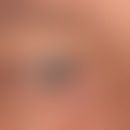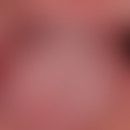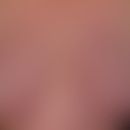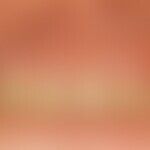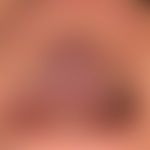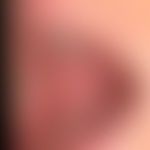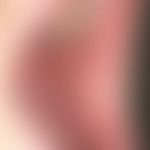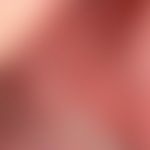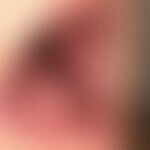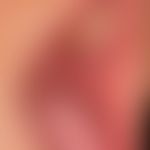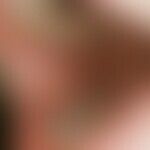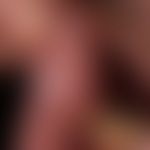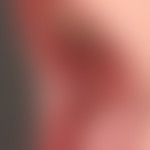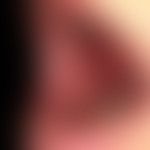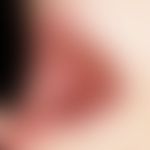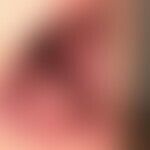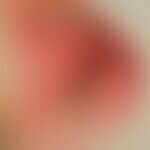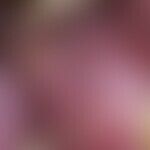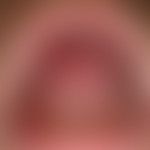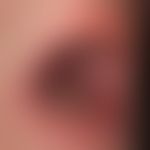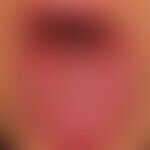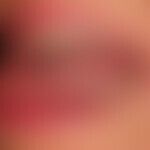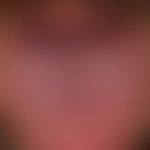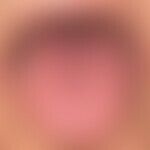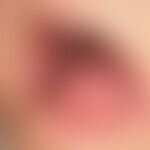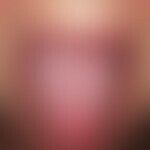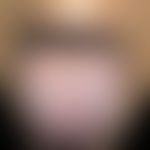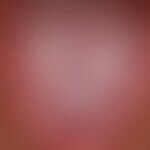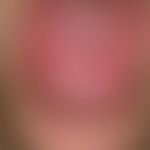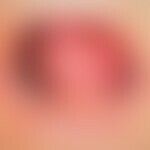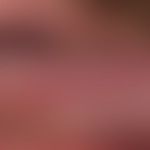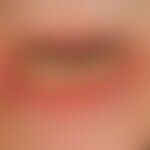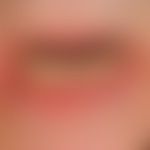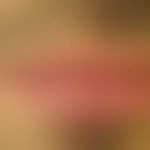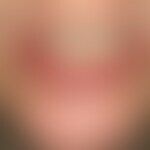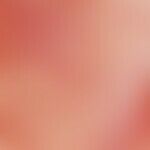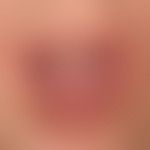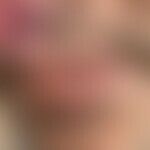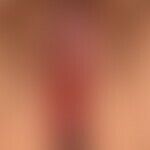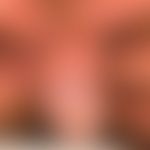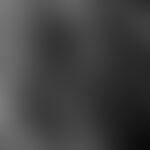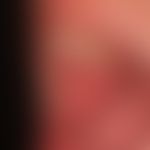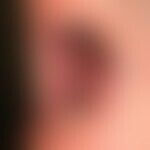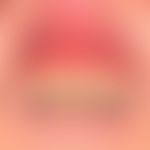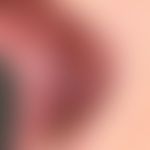Synonym(s)
DefinitionThis section has been translated automatically.
Limited to the mucosal area of keratinizing and non-keratinizing squamous epithelia (intestinal mucous membranes and mucous membranes of the urogenital tract are not affected!) or in the context of an integumentary lichen planus, polyetiologic, polymorphic, patchy or plaque-like (also reticular streaky) whitish-keratotic or, more rarely, flat erosive or vesicular/bullous lichen (ruber) planus (especially oral and/or genital mucosa). The oesophagus may also be affected. Its prevalence is unclear, as endoscopic examinations are rarely performed.
ClassificationThis section has been translated automatically.
From a clinical point of view, lichen planus mucosae can be divided as follows:
- Erosive lichen planus mucosae
- Non-erosive lichen planus mucosae
You might also be interested in
Occurrence/EpidemiologyThis section has been translated automatically.
Infestation of oral mucosa (mostly bilateral cheek infestation), tongue (especially lateral tongue areas), gums (90% of patients with lichen planus mucosae (LPM).
Genital mucosa: about 37.5% of LPM patients show discrete or distinct oral and/or vulvo-vaginal involvement.
The prevalence of oral LP (OLP) in the general population is about 1.5% (?)(Cramer N et al. 2025).
Patients with LPM show skin involvement in 28% of cases, nail involvement in 8% and scalp involvement in 6%.
w:m = 8:2 (Daidona D et al. 2024).
EtiopathogenesisThis section has been translated automatically.
The autoantigen that triggers the migration of T cells into the epithelium in oral lichen planus (OLP) is unknown (see lichen planus below). It is assumed that epidermal or dermal-epidermal antigens including desmogleins and BP180 (bullous pemphigoid antigen 180) are possible initiating antigens (detection of type I/17 autoreactive T cells against Bp180 and DSg3). Occasionally, humoral AK against these antigens are also detected. However, the antibodies have no acantholytic potential (DD against pemphigus vulgaris).
An autoimmunologic genesis can be assumed. In about 30% of patients with "vulvovagino-gingival syndrome" autoimmunological "concomitant diseases" such as diabetes mellitus, Hashimoto's thyroiditis (15%), vitiligo (5%), alopecia areata (4%), celiac disease, pernicious anemia, Sjögren's syndrome, idiopathic thrombocytopenic purpura are found.
A co-pathogenic role of hepatitis C infections and autoimmune thyroiditis is discussed (Schruf E et al. 2022).
Mechanotransduction: Mechanical stress plays a pathogenetic role in oral lichen planus. In patients with oral lichen planus, blood levels of angiotensin II are elevated, which activates and upregulates the mechanosensory receptor TRPA1 both in the lesions and in the unaffected skin. TRPA1 is usually induced by mechanical stress and promotes keratinocyte proliferation and local immune responses. Repeated and prolonged mechanical stresses in the oral cavity, such as mechanical trauma due to dental surgery, friction from sharp tooth edges and poor oral habits, activate TRPA1 and exacerbate oral lichen planus by KP(Eisen D 2002).
Familial clusters can be observed (in about 6% of patients/Cramer N et al. 2025)
Externa: Allergic reactions to amalgam or other materials used in dentistry (e.g. eugenol) are discussed and proven in individual cases of oral lichen planus.
ManifestationThis section has been translated automatically.
w:m = 8:2 (Daidona D et al. 2024)
The median age of onset at first diagnosis is between 40-60 years (11-94 years). In a larger study, the median age was 59.2 years.
Both monotopic oral and vulvovaginal LP tend to be chronic with continuous or discontinuous recurrent clinical courses over 3-10 years.
A mean duration of > 10 years (3-31 years) is reported for vulvovaginal-gingival syndrome.
Smoking does not appear to play a role in either the maintenance or the initiation of oral lichen planus.
LocalizationThis section has been translated automatically.
Oral mucosa (mostly bilateral cheek infestation), tongue (especially lateral parts of the tongue), gums (90% of patients with LPM).
Genital mucosa: about 37.5% of patients with LPM show discrete or distinct oral and/or vulvo-vaginal involvement.
ClinicThis section has been translated automatically.
See also Lichen planus.
Oral mucosa(oral lichen ruber/planus):
- OLP I (white papule or plaque type, most common type >90% of OLP cases): Mostly streaky, punctate, annular, reticular, also flat whitish papules or plaques, which may confluent into large opal plaques, especially retroangularly and in the area of the entire dental ridge(Köbner phenomenon). A small papular mucosal type is less common (see illustration). Underlying erythema (of lichen planus inflammation) is not always visible (masking phenomenon of superimposed orthokeratotic keratinization of the mucosa). The changes are usually moderately painful. Itching is also reported. The red of the lips may also be affected, but may also be affected in isolation. Occasionally, brownish hyperpigmentation occurs. The tongue can be affected by extensive opal plaques, which are only more visible when viewed from the side. Parallel to this, a coarsening of the surface relief can be observed (as an expression of the diffuse lichenoid inflammation). Some patients (about 1%) report taste disturbances.
- OLP 1II (red or erosive type): second most common manifestation (<10% of OLP cases) of lichen ruber mucosae (see below lichen ruber erosivus mucosae). This is characterized by considerably painful (especially when ingesting acidic food or drinks) flat erythema, erosions or flat ulcers. The main clinical symptom of the erosive type is "pain", which occurs promptly, especially with acidic food or drink. At 0.5-2.0%, erosive lichen ruber has a clear risk of malignant transformation. Although antibodies against Dsg are rare in OLP, they usually occur in erosive OLP!
- Type I/type II in various mixed forms.
- Lichen ruber mucosae is described as an "oral lichenoid reaction", which occurs in the immediate vicinity of amalgam fillings on the buccal mucosa, tongue or gingiva. Some authors postulate an independent entity (see notes below).
- Gingiva: Chronic desquamative gingivitis appears when the gingiva is affected. The "leukoplakic" aspect is often completely absent. Flat erythema or flat, very painful erosions appear, which increase in size during an acute attack and become symptomatic when acidic foods (e.g. orange juice) are consumed.
Genital mucosa:
- The genital mucosa is less frequently affected than the oral mucosa. The clinical symptoms are similar to those of the oral mucosa. Problems during sexual intercourse or burning discomfort when urinating usually lead to the doctor. A severe, chronic and scarring variant is referred to as"vulvovagino-gingival syndrome".
Oesophagus:
- Dysphagia is reported by one third of patients with lichen planus mucosae.
HistologyThis section has been translated automatically.
DiagnosisThis section has been translated automatically.
Initial consultations are made with the family doctor or dentist, followed by dermatologists. The correct classification is usually made by the dermatologist. Once the diagnosis has been made, interdisciplinary care should be sought.
Differential diagnosisThis section has been translated automatically.
Aphthae: Rapidly developing, solitary or multiple, painful, 0.2-0.5 cm, inflammatory, low-elevation mucosal infiltrates with central fibrin-covered erosion (rarely ulceration) and erythematous margins.
Leukoplakia: Male>female; ubiquitous in oral cavity; preferentially retroangular, floor of mouth, margins of tongue, vestibule oris, edentulous alveolar ridge. Usually circumscribed or large, grayish to off-white foci with smooth or bumpy surface; histologic confirmation.
Pemphigus vulgaris: Typical is a chronic insidious onset, fluctuating between improvement and recurrence. Note: Blisters are often not seen in this localized stage; thus, the disease is usually not clinically evaluated as blistering. Frequently (> 50%!) first clinical manifestations in the oral cavity (erosive, painful stomatitis, fetor ex ore).
Mucosal pemphigoid: Recurrent, erosive, painful stomatitis with rapidly bursting, scarring healing blisters (blisters often not detectable) on the palate, cheeks and gingiva. Usually simultaneous involvement of the conjunctiva (always absent in lichen ruber mucosae).
Chronic ulcerative stomatitis: Rare erosive disease of the oral mucosa. Especially women are affected. Characteristic is a fluorescent pattern with IgG antibodies and nuclear pattern of basal and suprabasal keratinocytes.
Complication(s)(associated diseasesThis section has been translated automatically.
In a larger collective, 8% of patients with lichen planus mucosae developed either carcinoma in situ or squamous cell carcinoma. In relation to the overall collective of lichen planus patients, the probability of malignant neoplasms of the lip or oral mucosa compared to controls is given as 0.99% compared to 0.14%.
TherapyThis section has been translated automatically.
Depending on the activity and extent of the lesions. Satisfactory results are only achieved with extensive symptoms through systemic therapy.
External therapyThis section has been translated automatically.
Smaller, non-erosive foci: In the case of non-erosive, clinically less troublesome foci, only a mild local therapy with mild, astringent stomatologics (e.g. Tormentill Astringens R255 ) or dexpanthenol solution (e.g. Bepanthen Lsg., R066 ) is necessary, if necessary this can also be dispensed with. In the case of isolated oligo- or asymptomatic mucosal infestation, such a procedure would also be preferable.
Localized non-erosive infestation of the lips: As only minor symptoms usually occur in this case, regular application of a lipstick is recommended. A lip ointment containing lanolin is also pleasant. Sun protection in summer!
Localized infestation of the lips with clinical symptoms (burning, pain): Lip cream containing lanolin as basic care, several times a day. Additive Ciclosporin-containing Externum. A ready-to-use preparation can be recommended here (Ikervis® eye drops), which should initially be applied daily. Light protection is required!
Large non-erosive foci: In the case of large, isolated mucosal infestation, consistent local therapy with vitamin A acid solution or gel R258 can be carried out (apply gel or solution to the mucosa using a toothbrush and leave on for a few minutes). If necessary, use alternately (or in combination) with a 0.1% betamethasone oral gel(betamethasone valerate adhesive paste 0.1% NRF 7.11.) or prednisolone acetate paste (Dontisolon® D oral healing paste). Celestamine liquidum®, which is left in the mouth for 2-3 minutes and then rinsed out, has also proved effective.
Inflammatory, erosive les ions (patients' quality of life is considerably impaired by these often chronic, painful changes to the oral mucosa).
- Local therapy with topical glucocorticoids, e.g. with 0.1% betamethasone oral gel (betamethasone valerate adhesive paste 0.1% NRF 7.11.), is possible as a "first step therapy".
- There is also good experience with Clobetasol® cream (e.g. apply Dermoxin® cream to a gauze-wrapped mouth spatula and apply locally).
- Alternatively, aqueous prednisolone or /hydrocortisone solutions are recommended (e.g. Rp.: Nystatin 100KUI/Lidocaine 0.1/Prednisolone 0.1/ aqua purificata ad 100.0/ S: Apply a mild, well-tolerated solution containing prednisolone 1-2 times daily; or a combination preparation of hydrocortisone acetate and tetracaine hydrochloride - Rp.: hydrocortisone acetate 1.0/ propylene glycol 37.3/ tetracaine hydrochloride 2.0/ guaiaculene 25% aqueous 0.05/ Cremophor RH40 0.4/ peppermint oil 0.3/ panthenol solution 5% 40.0/ dist. Water ad 285.0/S: Apply mild, well-tolerated solution containing hydrocortisone 1-4 times daily). Spraying the lesions several times a day with a nasal spray containing momethasone (e.g. Nasonex®-Supension) has proved successful
- Good results have been described with a paste containing CiclosporinA (Ciclosporin A adhesive paste 2.5) and a 0.03% Tacrolimus suspension (evidence level: B) (alternative: 1% Pimecrolimus cream, which is better tolerated in the mucous membrane area). Apply these topical preparations to the lesion with a soft toothbrush or on a spatula wrapped in gauze and leave on for as long as possible. Carry out the treatment 2-3 times a day.
- Topical preparations containing vitamin A acid are less suitable for this form (they are too irritating!).
Remember! In the case of pronounced clinical symptoms and chronicity, the previously described (symptomatic) local treatment is not sufficient!
Internal therapyThis section has been translated automatically.
First-line therapy:
- Acitretin and glucocorticoids: Therapy of first choice is the combination of acitretin and glucocorticoids. Acitretin (e.g. Neotigason) initially 0.5 mg/kg bw/day and prednisolone (e.g. Decortin H) initially 1 mg/kg bw/day p.o. Maintenance dose according to the clinic. The therapy must be carried out over weeks to months according to the clinical symptoms.
Alternative:
- Alternative: if not sufficient, combination therapy with azathioprine and systemic glucocorticoids is required: azathioprine (e.g. Imurek) initially 1.0-1.5 mg/kg bw/day and prednisolone (e.g. Decortin H) initially 1.0-1.5 mg/kg bw/day. Reduction of the dose according to the clinic.
- Alternative in case of resistance to therapy: monotherapy with Ciclosporin A (3.0-5.0 mg/kg bw/day p.o.) or mycophenolate mofetil (e.g. CellCept 2.0 g/day p.o.).
- Alternatively: methotrexate 10-15 mg/week p.o. As with other system therapeutics, months/years of therapy must be expected. Positive effects can be expected after 12 weeks of therapy.
- Alternative: use of biologics (TNF-alpha blockers). 4-week laboratory controls are necessary.
Experimental:
- A therapy targeting TRPA1 could contribute to the stabilization of oral lichen planus.
- In vulvo-vagino-gingival syndrome, the initial weight-adapted use of azathioprine (e.g. Imurek) 1.5-2.0 mg/kg bw/day p.o. is recommended , possibly in combination with a glucocorticoid in an initially medium dosage (e.g. prednisolone 0.5 mg/kg bw/day p.o.). Subsequently, clinically adapted lower dosage (5.0-7.5 mg/day p.o.).
- Secukinumab: A dosage of 300 mg/2 weeks showed a significant reduction in disease activity in patients with mucosal lichen planus (Passeron et al. 2024)
- Please note! All therapies presented here are "off-label use" applications. Scientific proof of the superiority of systemic therapy over local therapy has not yet been provided for oral (or vulvo-vaginal) LP.
Progression/forecastThis section has been translated automatically.
There is an increased risk (1-3%) of developing oral squamous cell carcinoma in oral LP. The WHO classifies oral lichen planus as a "premalignant condition" (van der Meij EH et al. 2003).
An increased risk of squamous cell carcinoma was also found for vulvar lichen planus. The rate of inguinal metastasis and recurrence is high, as is the disease-related mortality rate.
Both oral and vulvo-vaginal lichen planus are associated with an increased candidiasis rate.
NaturopathyThis section has been translated automatically.
Chamomile extracts: Chamomile rinses(Matricariae flos) applied several times a day can be used in natural medicine.
Alternative: Aloe vera: In small clinical studies (multiple) good effects are described for oral as well as genital lichen planus with locally applicable aloe vera preparations (e.g. 0.5% aloe vera gel) (Rajar DU et al. (2008).
Alternative: Local therapy with a mixture of eucalyptus oil, fennel oil, levomenthol, clove oil, peppermint oil, sage oil, star anise oil, thymol, cinnamon oil as offered in Salviathymol® N.
Alternative: clove oil: brushings with clove oil(Caryophylli floris aetheroleum).
Diet/life habitsThis section has been translated automatically.
Dietary measures: In the case of erosive Lichen planus mucosae, it is recommended to avoid pungent spices, fruit acids (vinegar, citrus fruits, wine and other spirits) of highly salted foods, as they cause a burning of the oral mucosa. Pay attention to sufficient nutrition (vitamins, minerals)!
When cleaning teeth, it is recommended to use a soft toothbrush and a mild toothpaste.
Note(s)This section has been translated automatically.
The formation of a compact hyperkeratosis is responsible for the leukoplakic aspect of mucosal lichen ruber. The water-storing horny layer swells, creating the opalescent frosted glass effect. The surface becomes opaque white.
Some authors differentiate oral lichenoid reaction (OLR) as an immunological hypersensitivity reaction clinically and histologically "similar" to lichen planus mucosae, to which a specific trigger can be assigned. These include drugs (NSAIDs, antihypertensives, retroviral drugs), contact allergens (dental materials, amalgam, copper, gold, eugenol), which by definition can be found up to 1.0 cm away from the OLR.
The syndromal occurrence of oral lichen planus, arterial hypertension and diabetes mellitus is referred to as"Grinspan syndrome".
LiteratureThis section has been translated automatically.
- Balestrini A et al. (2021) A TRPA1 inhibitor suppresses neurogenic inflammation and airway contraction for asthma treatment. J Exp Med 218:e20201637.
- Boyce AE et al. (2009) Erosive mucosal lichen planus and secondary epiphora responding to systemic cyclosporin A treatment. Australas J Dermatol 50:190-193
- Corrocher G et al. (2008) Comparative effect of tacrolimus 0.1% ointment and clobetasol 0.05% ointment in patients with oral lichen planus. J Clin Periodontol 35:244-249
- Cramer N et al. (2025) History, clinical presentation, therapy, and patient reported outcomes of mucosal lichen planus: a cross-sectional study. J Dtsch Dermatol Ges 23: 449-462.
- Didona D et al. (2024) Pathogenic relevance of antibodies against desmoglein 3 in patients with oral lichen planus. J Dtsch Dermatol Ges 22:1392-1399.
- Eisen D (2002) The clinical features, malignant potential, and systemic associations of oral lichen planus: a study of 723 patients. J Am Acad Dermatol 46: 207-214.
- Kökten N et al. (2018) Grinspan's Syndrome: A Rare Case with Malignant Transformation. Case Rep Otolaryngol doi: 10.1155/2018/9427650.
- Lauritano D et al. (2016) Oral lichen planus clinical characteristics in Italian patients: a retrospective analysis. Head Face Med 12:18.
- Mehlika B et al. (2014) Contact allergic lichenoid reaction to eugenol under the picture of lichen planus mucosae. Allergo J Int 23: 14-17
- Mansourian A et al. (2011) Comparison of aloe vera mouthwash with triamcinolone acetonide 0.1% on oral lichen planus: a randomized double-blinded clinical trial.Am J Med Sci 342:447-451.
- Mozafari N et al. (2022) Hypertrophic lichen planus on lip mimicking SCC. Clin Case Rep10:e6191.
- Ohno S et al. (2011) Enhanced expression of Toll-like receptor 2 in lesional tissues and peripheral blood monocytes of patients with oral lichen planus. J Dermatol 38:335-344
- Passeron T et al. (2024) Secukinumab in adult patients with lichen planus: efficacy and safety results from the randomized placebo-controlled proof-of-concept PRELUDE study. Br J Dermatol 191:680-690.
- Poomsawat S et al. (2011) Overexpression of cdk4 and p16 in oral lichen planus supports the concept of premalignancy. J Oral Pathol Med 40:294-249
- Rajar UD et al. (2008) Efficacy of aloe vera gel in the treatment of vulval lichen planus. J Coll Physicians Surg Pak 18:612-614.
- Schruf E et al. (2021) Lichen planus in Germany-epidemiology, treatment and morbidity. A retrospective analysis of health insurance data. JDDG: 1101-1111.
- Simark-Mattsson C et al. (2013) Reduced immune responses to purified protein derivative and Candida albicans in oral lichen planus. J Oral Pathol Med 42:691-697
- van der Meij EH et al.(2003) The possible premalignant character of oral lichen planus and oral lichenoid lesions: a prospective study.Oral Surg Oral Med Oral Pathol Oral Radiol Endod 96:164-171.
Incoming links (23)
Aloe barbadensis; Amalgam allergy; Betamethasone valerate adhesive paste 0.1% (nrf 7.11.); Candidiasis vulvovaginale; Cheek ulcer, neurotic; Chronic ulcerative stomatitis; Ciclosporin a; Ciclosporin a adhesive paste 2,5%.; Defensin, alpha 1; Dexpanthenol solution 5% (nrf 7.3.); ... Show allOutgoing links (37)
Acitretin; Aloe vera gel; Amalgam allergy; Azathioprine; Betamethasone valerate adhesive paste 0.1% (nrf 7.11.); Chronic ulcerative stomatitis; Ciclosporin a; Ciclosporin a adhesive paste 2,5%.; Cinnamontree ceylonesic; Dexpanthenol solution 5% (nrf 7.3.); ... Show allDisclaimer
Please ask your physician for a reliable diagnosis. This website is only meant as a reference.
